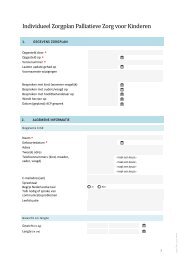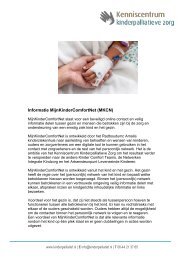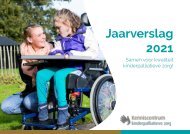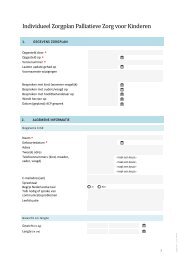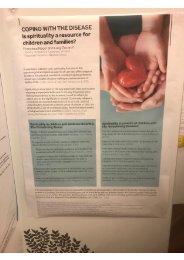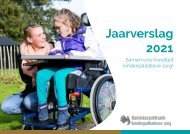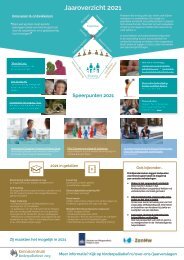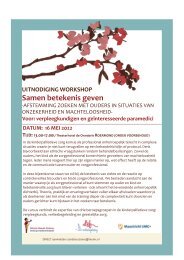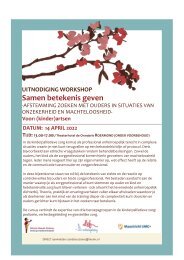EAPC Atlas of Palliative Care in Europe 2019
Conclusion: PC health policies developed in recent years have promoted vigorous development across Europe. Preliminary data on the integration of PC into different fields are encouraging though inequalities between countries and sub-regions persist. Further comparative analysis exploring factors leading to uneven progress may inform strategies to provide PC for all people in need. Per land is de stand van zaken van de (kinder)palliatieve zorg weergegeven.
Conclusion: PC health policies developed in recent years have promoted vigorous development across Europe. Preliminary data on the integration of PC into different fields are encouraging though inequalities between countries and sub-regions persist. Further comparative analysis exploring factors leading to uneven progress may inform strategies to provide PC for all people in need.
Per land is de stand van zaken van de (kinder)palliatieve zorg weergegeven.
Create successful ePaper yourself
Turn your PDF publications into a flip-book with our unique Google optimized e-Paper software.
METHODS OF THE PROJECT<br />
B<br />
Step 1: Systematic review<br />
We conducted a systematic review to identify the most commonly<br />
used national-level <strong>in</strong>dicators on palliative care development<br />
<strong>in</strong> cross-national studies. Articles <strong>in</strong>cluded fulfilled the follow<strong>in</strong>g<br />
<strong>in</strong>clusion criteria: mention (1) palliative care development,<br />
AND/OR; (2) palliative medic<strong>in</strong>e development, AND/OR; (3) hospice<br />
and PC nurs<strong>in</strong>g development, AND; (4) use <strong>of</strong> <strong>in</strong>dicators that<br />
allow cross-national comparison <strong>of</strong> at least two countries, AND;<br />
(5) report on national-level development or status, AND; and (6)<br />
published between January 1, 2008 and July 31, 2017. Peer-reviewed<br />
literature was searched us<strong>in</strong>g PubMed and CINAHL, and an<br />
additional search was conducted on Google Scholar and Google<br />
to assess grey literature. The follow<strong>in</strong>g Mesh terms were used <strong>in</strong><br />
the search: [(<strong>Palliative</strong> <strong>Care</strong> OR Hospice <strong>Care</strong>), (Development OR<br />
Provision OR Mapp<strong>in</strong>g), and (National OR International)].<br />
Articles and reports found were assessed by title and abstract.<br />
National-level <strong>in</strong>dicators were compiled and clustered by dimensions<br />
<strong>of</strong> the WHO Public Health Strategy, plus two additional categories:<br />
research and vitality (pr<strong>of</strong>essional activity). With<strong>in</strong> clusters,<br />
each <strong>in</strong>dicator was labelled with frequency <strong>of</strong> appearance and <strong>in</strong><br />
the end 38 <strong>in</strong>dicators were selected. The six most frequently used<br />
<strong>in</strong>dicators were the number <strong>of</strong> palliative care services per population,<br />
the existence <strong>of</strong> a national palliative care plan, strategy, or<br />
programme, the existence <strong>of</strong> palliative medic<strong>in</strong>e specialisation,<br />
the availability and allocation <strong>of</strong> funds for palliative care, the proportion<br />
<strong>of</strong> medical schools <strong>in</strong>clud<strong>in</strong>g PC <strong>in</strong> undergraduate curricula,<br />
and the consumption <strong>of</strong> opioids.<br />
While there were several <strong>in</strong>dicators assess<strong>in</strong>g development at the<br />
level <strong>of</strong> general health care provision, there was a clear lack <strong>of</strong> <strong>in</strong>dicators<br />
assess<strong>in</strong>g <strong>in</strong>tegration <strong>of</strong> palliative care <strong>in</strong>to health systems.<br />
We refer to <strong>in</strong>dicators on the development <strong>of</strong> paediatric palliative<br />
care, the provision <strong>of</strong> palliative care at long-term care facilities, at<br />
the primary care level, <strong>in</strong> malignant and non-communicable diseases<br />
and on the <strong>in</strong>tegration with volunteers (Arias-Casais, 2018).<br />
Step 2: Consensus process with the<br />
committee <strong>of</strong> <strong>in</strong>ternational experts<br />
A group <strong>of</strong> <strong>in</strong>ternational experts on palliative care development<br />
were <strong>in</strong>vited to participate <strong>in</strong> a two-round modified RAND/UCLA<br />
Delphi consensus process to select the best <strong>in</strong>dicators result<strong>in</strong>g<br />
from the review. Expert selection criteria <strong>in</strong>cluded: a) experience<br />
with national-level <strong>in</strong>dicators for palliative care, b) experience <strong>in</strong><br />
palliative care development evaluation projects, and c) participation<br />
<strong>in</strong> palliative care networks or advocacy activities for at least<br />
four years. Forty-four experts were <strong>in</strong>vited to participate, <strong>of</strong> which<br />
thirty assessed 45 <strong>in</strong>dicators by relevance, measurability and feasibility<br />
(1-9). These three scores were used to calculate a Global<br />
Score (1-9). Indicators scor<strong>in</strong>g >7 proceeded to the second round,<br />
<strong>in</strong> which experts assessed 34/45 <strong>in</strong>dicators. Median, Confidence<br />
Interval (CI), Content Validity Index (I-CVI), and Disagreement<br />
Index were calculated. Indicators scor<strong>in</strong>g a 95% CI ≥7 and an I-CVI<br />
≥0.30 were selected.<br />
Twenty-four experts (see the International Committee <strong>of</strong> experts<br />
on <strong>in</strong>dicators) represent<strong>in</strong>g five cont<strong>in</strong>ents and several organisations<br />
completed the study. Twenty-five <strong>in</strong>dicators showed a high<br />
content validity and level <strong>of</strong> agreement. They were thus selected<br />
as 25 <strong>of</strong> the best <strong>in</strong>dicators to assess national-level palliative<br />
care development. Policy <strong>in</strong>dicators <strong>in</strong>cluded –among others- the<br />
existence <strong>of</strong> designated staff <strong>in</strong> the national M<strong>in</strong>istry <strong>of</strong> Health, the<br />
<strong>in</strong>clusion <strong>of</strong> palliative care services <strong>in</strong> the basic health package and<br />
<strong>in</strong> the primary care list <strong>of</strong> services. Education <strong>in</strong>dicators focused<br />
on processes <strong>of</strong> <strong>of</strong>ficial specialisation for physicians, <strong>in</strong>clusion <strong>of</strong><br />
teach<strong>in</strong>g at the undergraduate level and existence <strong>of</strong> palliative care<br />
pr<strong>of</strong>essors. Use <strong>of</strong> medic<strong>in</strong>es <strong>in</strong>dicators consisted <strong>of</strong> opioid consumption,<br />
availability and prescription requirements whereas services<br />
<strong>in</strong>dicators <strong>in</strong>cluded ma<strong>in</strong>ly number and types <strong>of</strong> services for<br />
adults and children. Additional <strong>in</strong>dicators for pr<strong>of</strong>essional activity<br />
were identified (Arias-Casais, <strong>2019</strong>). These <strong>in</strong>dicators were used<br />
to create the <strong>2019</strong> <strong>EAPC</strong> <strong>Atlas</strong> <strong>of</strong> <strong>Palliative</strong> <strong>Care</strong> survey, which was<br />
sent to key <strong>in</strong>formants <strong>in</strong> each country.<br />
Cover <strong>of</strong> Brief Manual<br />
on Health Indicators<br />
to Assess Global<br />
<strong>Palliative</strong> <strong>Care</strong><br />
Development.<br />
<strong>EAPC</strong> <strong>Atlas</strong> <strong>of</strong> <strong>Palliative</strong> <strong>Care</strong> <strong>in</strong> <strong>Europe</strong><br />
37




